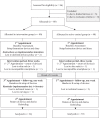Improving Sleep Among Teachers: an Implementation-Intention Intervention
- PMID: 35233749
- PMCID: PMC9879815
- DOI: 10.1007/s12529-022-10069-7
Improving Sleep Among Teachers: an Implementation-Intention Intervention
Abstract
Background: Insufficient sleep is common among teachers and is associated with diverse health risks. This study aimed to predict intention and sleep duration by applying the Theory of Planned Behavior (TPB) and to examine the effectiveness of an implementation-intention intervention to improve sleep duration and quality.
Method: Sixty-nine teachers (M = 36.8 years, SD = 10.4) were assigned to an active control group (CG) or intervention group (IG). At baseline, TPB variables were assessed and participants of the IG received instructions to develop implementation intentions to reach the goal of sleeping 8 h on average. During a 3-week intervention period, all participants wore an activity tracker (Fitbit Charge HR) to measure sleep duration and kept diaries to assess sleep quality, physical activity, and stress. After 1 month, a 1-week follow-up, including a booster for the IG, was conducted.
Results: Forty-two percent of variance in sleep duration were explained by control variables, past behavior, perceived behavioral control, and intention. Mixed ANOVAS with baseline covariates found a large main effect with longer sleep duration in the IG. A time x group interaction suggested that only the IG slept significantly longer in the follow-up period compared to the intervention period. For sleep quality, a medium-sized main effect for study group was found and a time x group interaction indicated higher sleep quality in the IG for week 3 and the follow-up.
Conclusion: The TPB was effective in predicting sleep intention and duration. Implementation intentions accompanied by daily monitoring and a booster appear to be promising for improving sleep.
Keywords: Implementation intentions; Self-monitoring; Sleep duration; Sleep quality; Teachers; Theory of planned behavior.
© 2022. The Author(s).
Conflict of interest statement
The authors declare no competing interests.
Figures



References
-
- Johnson S, Cooper C, Cartwright S, Donald I, Taylor P, Millet C. The experience of work-related stress across occupations. J Manag Psychol. 2005;20(2):178–187. doi: 10.1108/02683940510579803. - DOI
MeSH terms
LinkOut - more resources
Full Text Sources
Miscellaneous

